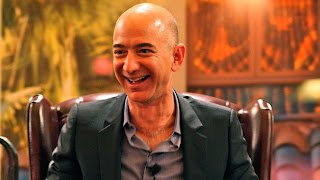
Amazon CEO Jeff Bezos
Despite being five times the size of its next 14-largest cloud competitors, Amazon isn't content. It wants the enterprise, too, and all signs point to a major push to dominate enterprise cloud computing, just as it does public cloud computing.
Game over?
Amazon's Hiring Binge
Earlier this year I reported that much of AWS' business was concentrated on small to medium-sized enterprises, and often even this was test and development workloads. To win the cloud war, Amazon had to get serious about the enterprise. And it has.
As Business Insider reported in March, AWS has been on a serious hiring binge, pulling in over 200 enterprise salespeople since 2011, and retaining over 95% of these. While most have been account executives, AWS has also pulled a few big-name coups, like hiring VMware sales vice president Mike Clayville.
I personally have seen several friends from Microsoft, Red Hat and other companies join the AWS team. Each of them has been what I'd term an "A" player. Back in 2011, Amazon hardly employed anyone to sell its still nascent cloud services, and those that were involved might not have been the strongest employees. Today, there are hundreds of Amazon folks affiliated with AWS sales on LinkedIn, and if my personal sampling is any indication, these are quality hires.
Part of what Amazon has had to do to appeal to the enterprise is, of course, to provide appropriate technology and service levels. But getting people in front of CIOs with big budgets is equally important, and that's clearly happening:
@wattersjames @gigabarb @marklucovsky AWS have been hiring enterprise sales guys for at least 12 months in UK. Would assume US ahead of that — Ant Stanley (@IamStan) September 2, 2013
This hiring boom is critical because we're in the early days of an enterprise cloud Gold Rush.
Enterprise IT: More And Faster Adoption Of Cloud
According to new data from Gartner, a mere 38% of enterprises are running cloud services today. But a whopping 80% expect to adopt cloud services within the next 12 months, including 55% of those that currently don't have any cloud services running. A mere 6% expect to decrease their investments in cloud services over the next few years.
And they are almost certainly wrong.
As Gartner notes, there are three primary drivers of cloud adoption in the enterprise:
The road to increased cloud usage will be through tactical business solutions addressing specific problems, not through broad, strategic infrastructure replacements.
The business impact of cloud services increases as they continue to move up the cloud services value chain, from infrastructure services to business process services.
The introduction of cloud solutions will lead to a more diverse solution portfolio with widely varying implementation and migration timelines.
Each of these factors will be heavily influenced by a strong enterprise sales force. While some businesses have managed to thrive without an enterprise sales force (e.g., Atlassian), these are the exception, not the rule. No enterprise spends millions of dollars with a credit card over the web.
And it is invaluable to have a relationship with a prospective customer when she's evaluating tactical projects. Though open source and cloud have both enabled enterprises to evaluate technology without dealing with a sales representative, it's still the case that big purchases nearly always involve a trusted sales advisor. By hiring an army of such advisors, Amazon has positioned itself to influence the next generation of IT decisions.
The Future Of The Enterprise
Not that Amazon is going to turn into a crufty, old-school enterprise software vendor tomorrow. It's still Jeff Bezos' baby, running on incredibly lean margins. The AWS enterprise sales team is a means to an end, and that end is more mission-critical enterprise workloads running on AWS. To get there, Amazon needs to help CIOs understand what developers already know: the cloud is the first-choice platform for the next-generation applications.








